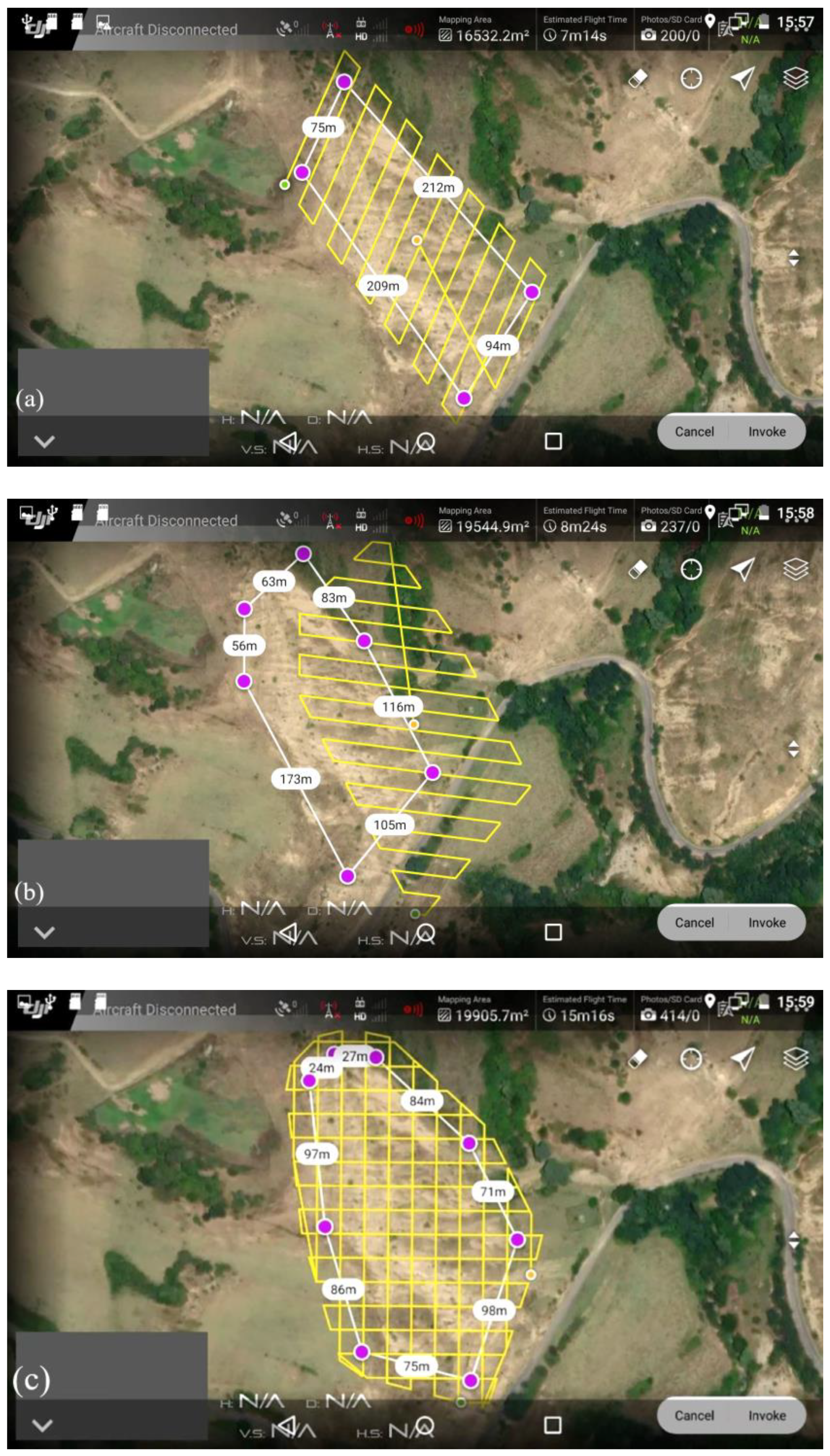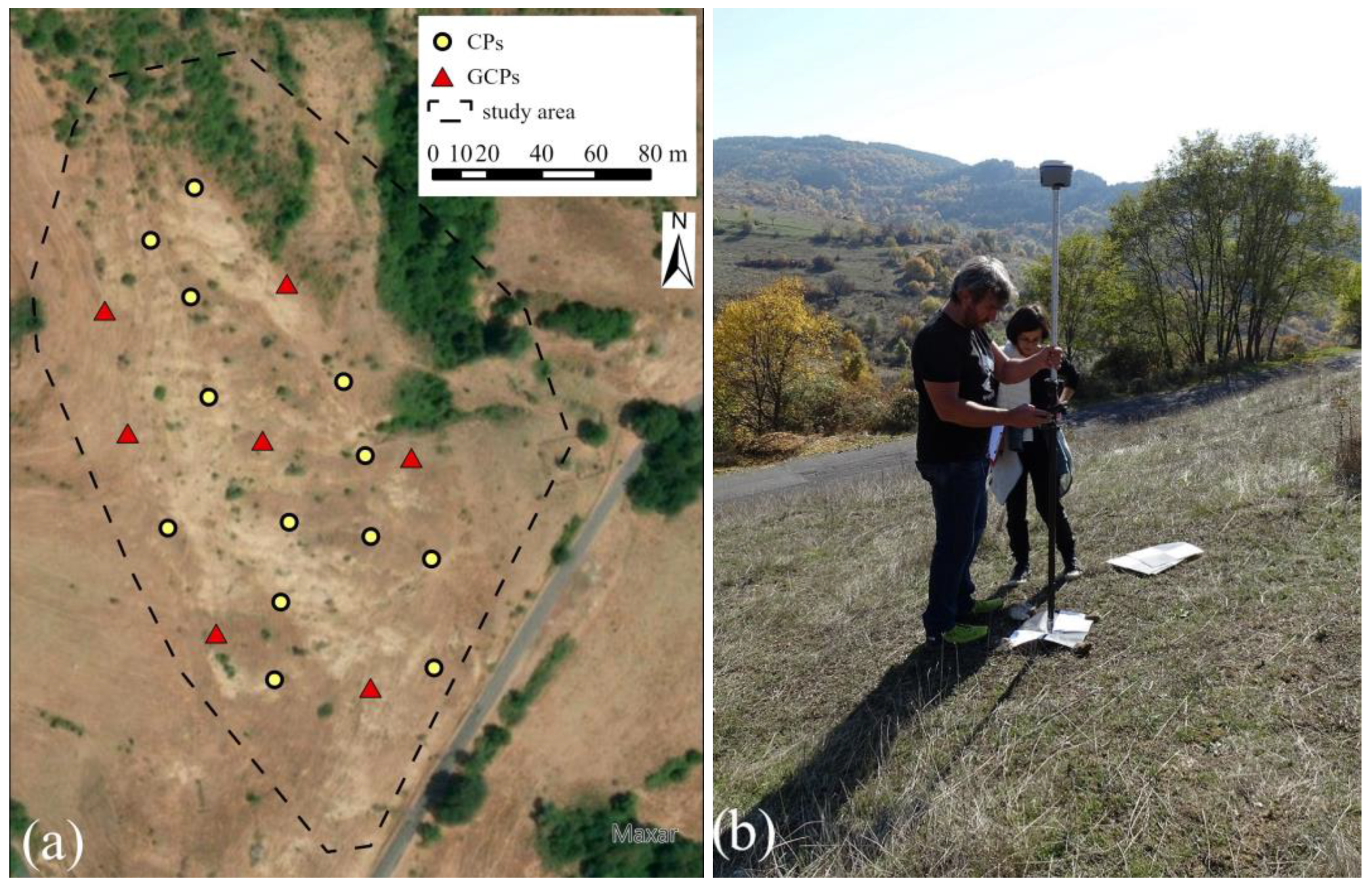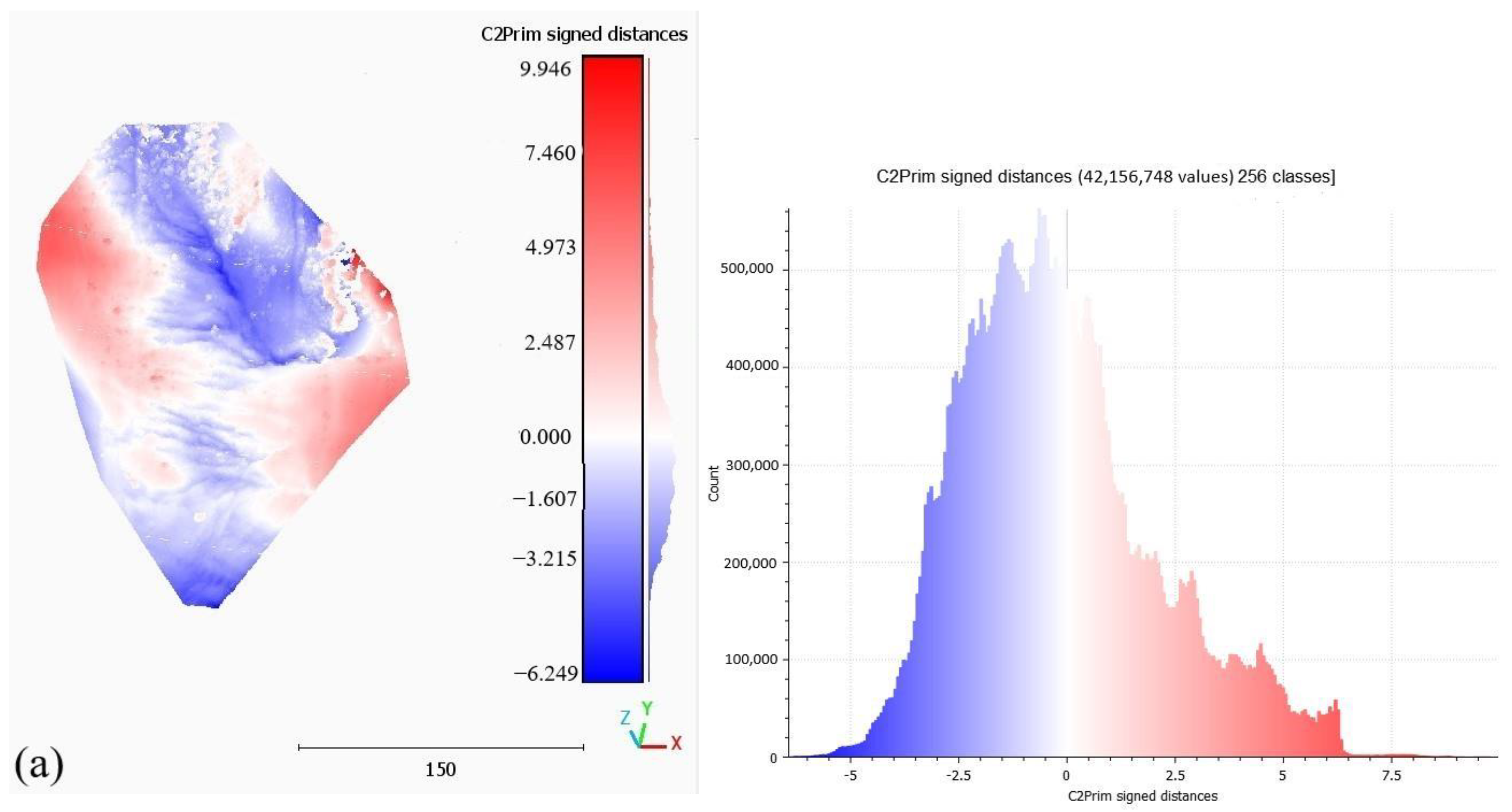Assessment of Unmanned Aerial System Flight Plans for Data Acquisition from Erosional Terrain
Abstract
:1. Introduction
2. Materials and Methods
2.1. Study Area
2.2. Equipment and Data Collection
2.3. Photogrammetric Processing and Analysis of the Photogrammetric Products
- Point clouds comparison—cloud to plane and cloud to cloud distances
- Evaluation of the DSMs
- Orthophotos
3. Results
3.1. Point Clouds
3.2. Digital Surface Models
3.3. Orthophotos
4. Discussion
5. Conclusions
Author Contributions
Funding
Data Availability Statement
Acknowledgments
Conflicts of Interest
References
- Liu, W.-C.; Huanga, W.-C. Close range digital photogrammetry applied to topography and landslide measurements. Int. Arch. Photogramm. Remote Sens. Spat. Inf. Sci. 2016, 41, 875–880. [Google Scholar] [CrossRef]
- Mokhtar, M.R.M.; Wahab, S.N.A.; Bin, M.N.; Hashim, H.H.; Kasim, A.C. Landslide monitoring using close range photogrammetry. Plan. Malays. J. Malays. Inst. Plan. 2021, 19, 160–168. [Google Scholar] [CrossRef]
- Bazzoffi, P. Measurement of rill erosion through a new UAV-GIS methodology. Ital. J. Agron. 2015, 10 (Suppl. S1), 708. [Google Scholar] [CrossRef]
- Krenz, J.; Greenwood, P.; Kuhn, N.J. Soil degradation mapping in drylands using unmanned aerial vehicle (UAV) data. Soil Syst. 2019, 3, 33. [Google Scholar] [CrossRef]
- Liao, K.; Song, Y.; Xie, S.; Zheng, H. Monitoring of Benggang erosion based on UAV photogrammetry technology. IOP Conf. Ser. Earth Environ. Sci. 2019, 330, 052003. [Google Scholar] [CrossRef]
- Urban, R.; Štroner, M.; Blistan, P.; Kovanič, L.; Patera, M.; Jacko, S.; Ďuriška, I.; Kelemen, M.; Szabo, S. The suitability of UAS for mass movement monitoring caused by torrential rainfall—A study on the talus cones in the Alpine terrain in High Tatras, Slovakia. ISPRS Int. J. Geo.-Inf. 2019, 8, 317. [Google Scholar] [CrossRef]
- Ullman, S. The interpretation of structure from motion. Proc. R. Soc. Lond. 1979, 203, 405–426. [Google Scholar]
- Westoby, M.J.; Brasington, J.; Glasser, N.F.; Hambrey, M.J.; Reynolds, J.M. ‘Structure-from-motion’ photogrammetry: A low-cost, effective tool for geoscience applications. Geomorphology 2012, 179, 300–314. [Google Scholar] [CrossRef]
- Eltner, A.; Sofia, G. Structure from motion photogrammetric technique. Dev. Earth Surf. Process. 2020, 23, 1–24. [Google Scholar] [CrossRef]
- Rosas, M.A.; Clapuyt, F.; Viveen, W.; Vanacker, V. Quantifying geomorphic change in Andean river valleys using UAV-PPK-SfM techniques: An example from the western Peruvian Andes. Geomorphology 2023, 435, 108766. [Google Scholar] [CrossRef]
- Nikolakopoulos, K.G.; Kyriou, A.; Koukouvelas, I.K. Developing a Guideline of Unmanned Aerial Vehicle’s Acquisition Geometry for Landslide Mapping and Monitoring. Appl. Sci. 2022, 12, 4598. [Google Scholar] [CrossRef]
- James, M.R.; Robson, S.; D’Oleire-Oltmanns, S.; Niethammer, U. Optimising UAV Topographic Surveys Processed with Structurefrom-Motion: Ground Control Quality, Quantity and Bundle Adjustment. Geomorphology 2017, 280, 51–66. [Google Scholar] [CrossRef]
- Forlani, G.; Dall’Asta, E.; Diotri, F.; Cella, U.M.d.; Roncella, R.; Santise, M. Quality Assessment of DSMs Produced from UAV Flights Georeferenced with On-Board RTK Positioning. Remote Sens. 2018, 10, 311. [Google Scholar] [CrossRef]
- Nota, E.W.; Nijland, W.; De Haas, T. Improving UAV-SfM time-series accuracy by co-alignment and contributions of ground control or RTK positioning. Int. J. Appl. Earth Obs. Geoinf. 2022, 109, 102772. [Google Scholar] [CrossRef]
- Zimmerman, T.; Jansen, K.; Miller, J. Analysis of UAS Flight Altitude and Ground Control Point Parameters on DEM Accuracy along a Complex, Developed Coastline. Remote Sens. 2020, 12, 2305. [Google Scholar] [CrossRef]
- Lee, S.; Park, J.; Choi, E.; Kim, D. Factors Influencing the Accuracy of Shallow Snow Depth Measured Using UAV-based Photogrammetry. Remote Sens. 2021, 13, 828. [Google Scholar] [CrossRef]
- Seifert, E.; Seifert, S.; Vogt, H.; Drew, D.; Van Aardt, J.; Kunneke, A.; Seifert, T. Influence of Drone Altitude, Image Overlap, and Optical Sensor Resolution on Multi-view Reconstruction of Forest Images. Remote Sens. 2019, 11, 1252. [Google Scholar] [CrossRef]
- Kyriou, A.; Nikolakopoulos, K.; Koukouvelas, I. How image acquisition geometry of UAV campaigns affects the derived products and their accuracy in areas with complex geomorphology. ISPRS Int. J. Geo.-Inf. 2021, 10, 408. [Google Scholar] [CrossRef]
- Jiménez-Jiménez, S.I.; Ojeda-Bustamante, W.; de Jesús Marcial-Pablo, M.; Enciso, J. Digital Terrain Models Generated with Low-Cost UAV Photogrammetry: Methodology and Accuracy. ISPRS Int. J. Geo.-Inf. 2021, 10, 285. [Google Scholar] [CrossRef]
- Amrullah, C.; Suwardhi, D.; Meilano, I. Product accuracy effect of oblique and vertical non-metric digital camera utilization in UAV-photogrammetry to determine fault plane. ISPRS Ann. Photogramm. Remote Sens. Spat. Inf. Sci. 2016, III-6, 41–48. [Google Scholar] [CrossRef]
- Rossi, P.; Mancini, F.; Dubbini, M.; Mazzone, F.; Capra, A. Combining nadir and oblique UAV imagery to reconstruct quarry topography: Methodology and feasibility analysis. Eur. J. Remote Sens. 2017, 50, 211–221. [Google Scholar] [CrossRef]
- Nesbit, P.R.; Hugenholtz, C.H. Enhancing UAV–SfM 3D model accuracy in high-relief landscapes by incorporating oblique images. Remote Sens. 2019, 11, 239. [Google Scholar] [CrossRef]
- Nesbit, P.R.; Hubbard, S.M.; Hugenholtz, C.H. Direct Georeferencing UAV-SfM in High-Relief Topography: Accuracy Assessment and Alternative Ground Control Strategies along Steep Inaccessible Rock Slopes. Remote Sens. 2022, 14, 490. [Google Scholar] [CrossRef]
- Parmehr, E.G.; Savadkouhi, M.; Nopour, M. The impact of oblique images and flight-planning scenarios on the accuracy of UAV 3D mapping. Photogramm. Rec. 2023, 38, 563–580. [Google Scholar] [CrossRef]
- Lague, D.; Brodu, N.; Leroux, J. Accurate 3D comparison of complex topography with terrestrial laser scanner: Application to the Rangitikei canyon (N-Z). ISPRS J. Photogramm. Remote Sens. 2013, 82, 10–26. [Google Scholar] [CrossRef]
- Jordanov, B.; Sarov, S.; Georgiev, S.; Valkov, V.; Balkanska, E.; Grozdev, V.; Marinova, R.; Markov, N. Explanatory Note to Geological Map of Bulgaria, 1:50,000, Map Sheet K-35-75-G (Nikolovo); Ministry of Environment and Water, Bulgarian Geological Survey, Uniscorp Ltd.: Sofia, Bulgaria, 2008; p. 92. (In Bulgarian) [Google Scholar]
- DJI. Phantom 4 RTK User Manual, v.2.4. 2021. Available online: https://dl.djicdn.com/downloads/phantom_4_rtk/20210716/Phantom_4_RTK_User_Manual_v2.4_EN.pdf (accessed on 20 July 2023).
- Liu, Y.; Han, K.; Rasdorf, W. Assessment and Prediction of Impact of Flight Configuration Factors on UAS-Based Photogrammetric Survey Accuracy. Remote Sens. 2022, 14, 4119. [Google Scholar] [CrossRef]
- Haala, N.; Cramer, M.; Rothermel, M. Quality of 3D point clouds from highly overlapping UAV imagery. Int. Arch. Photogramm. Remote Sens. Spat. Inf. Sci. 2013, 40, 183–188. [Google Scholar] [CrossRef]
- Losè, T.L.; Chiabrando, F.; Tonolo, F.G. Boosting the timeliness of UAV large scale mapping. Direct georeferencing approaches: Operational strategies and best practices. ISPRS Int. J. Geo.-Inf. 2020, 9, 578. [Google Scholar] [CrossRef]
- Štroner, M.; Urban, R.; Seidl, J.; Reindl, T.; Brouček, J. Photogrammetry using UAV-mounted GNSS RTK: Georeferencing strategies without GCPs. Remote Sens. 2021, 13, 1336. [Google Scholar] [CrossRef]
- Agisoft LLC. Agisoft Metashape Professional. 2020. Available online: https://www.agisoft.com/pdf/metashape-pro_2_0_en.pdf (accessed on 1 December 2023).
- Özyeşil, O.; Voroninski, V.; Basri, R.; Singer, A. A survey of structure from motion. Acta Numer. 2017, 26, 305–364. [Google Scholar] [CrossRef]
- Lowe, D. Distinctive image features from scale-invariant keypoints. Int. J. Comput. Vis. 2004, 60, 91–110. [Google Scholar] [CrossRef]
- CloudCompare (Version 2.13 Beta) [GPL Software]. 2023. Available online: https://www.danielgm.net/cc/ (accessed on 28 November 2023).
- Zhang, W.; Qi, J.; Wan, P.; Wang, H.; Xie, D.; Wang, X.; Yan, G. An Easy-to-Use Airborne LiDAR Data Filtering Method Based on Cloth Simulation. Remote Sens. 2016, 8, 501. [Google Scholar] [CrossRef]
- ESRI Inc. ArcGIS Pro Software; version 3.2.1; ESRI Inc.: Redlands, CA, USA, 2023. [Google Scholar]
- Sammartano, G.; Chiabrando, F.; Spanò, A. Oblique images and direct photogrammetry with a fixed wing platform: First test and results in Hierapolis of Phrygia (TK). ISPRS Int. Arch. Photogramm. Remote Sens. Spat. Inf. Sci. 2020, 43, 75–82. [Google Scholar] [CrossRef]
- James, M.R.; Robson, S. Mitigating systematic error in topographic models derived from UAV and ground-based image networks. Earth Surf. Process. Landf. 2014, 39, 1413–1420. [Google Scholar] [CrossRef]
- Jaud, M.; Letortu, P.; Théry, C.; Grandjean, P.; Costa, S.; Maquaire, O.; Davidson, R.; Le Dantec, N. UAV survey of a coastal cliff face—Selection of the best imaging angle. Measurement 2019, 139, 10–20. [Google Scholar] [CrossRef]
- Śledź, S.; Ewertowski, M.W. Evaluation of the Influence of Processing Parameters in Structure-from-Motion Software on the Quality of Digital Elevation Models and Orthomosaics in the Context of Studies on Earth Surface Dynamics. Remote Sens. 2022, 14, 1312. [Google Scholar] [CrossRef]
- Meinen, B.U.; Robinson, D.T. Mapping erosion and deposition in an agricultural landscape: Optimization of UAV image acquisition schemes for SfM-MVS. Remote Sens. Environ. 2020, 239, 111666. [Google Scholar] [CrossRef]









| Indicator | Value |
|---|---|
| UAV altitude (m) | 60 |
| Ground sample distance (cm) | 1.67 ≈ 2 |
| Along the track overlap (%) | 80 |
| Across the track overlap (%) | 80 |
| Point | Northing | Easting | Height (m) | Hz. RMS (m) | Vert. RMS (m) | Satellites Used |
|---|---|---|---|---|---|---|
| 1 | 4618381.220 | 359135.010 | 613.960 | 0.018 | 0.026 | 31 |
| 2 | 4618371.366 | 359067.864 | 642.235 | 0.017 | 0.023 | 35 |
| 3 | 4618326.176 | 359076.314 | 637.090 | 0.018 | 0.024 | 35 |
| 4 | 4618252.511 | 359108.964 | 623.773 | 0.019 | 0.024 | 37 |
| 5 | 4618232.469 | 359165.857 | 605.703 | 0.018 | 0.025 | 34 |
| 6 | 4618317.131 | 359180.885 | 603.648 | 0.020 | 0.026 | 32 |
| 7 | 4618323.493 | 359126.056 | 619.714 | 0.020 | 0.027 | 31 |
| 100 | 4618416.033 | 359101.018 | 625.236 | 0.019 | 0.026 | 32 |
| 101 | 4618396.905 | 359084.878 | 631.483 | 0.019 | 0.026 | 32 |
| 102 | 4618290.638 | 359091.014 | 630.283 | 0.018 | 0.024 | 35 |
| 103 | 4618234.896 | 359130.596 | 616.081 | 0.018 | 0.024 | 36 |
| 104 | 4618239.270 | 359189.416 | 600.595 | 0.019 | 0.025 | 34 |
| 105 | 4618279.774 | 359188.594 | 601.805 | 0.019 | 0.026 | 35 |
| 106 | 4618344.579 | 359155.869 | 607.370 | 0.020 | 0.026 | 30 |
| 107 | 4618338.956 | 359106.313 | 623.936 | 0.021 | 0.027 | 32 |
| 108 | 4618375.844 | 359099.596 | 628.198 | 0.021 | 0.028 | 32 |
| 109 | 4618263.361 | 359132.658 | 615.944 | 0.019 | 0.025 | 35 |
| 110 | 4618287.738 | 359166.025 | 608.150 | 0.020 | 0.025 | 35 |
| 111 | 4618292.918 | 359135.854 | 615.921 | 0.020 | 0.027 | 36 |
| 112 | 4618317.514 | 359163.893 | 607.896 | 0.019 | 0.025 | 30 |
| Capture Type | Average Camera Location Error Total Error (cm) | RMSE (m) GCPs | RMSE (m) CPs |
|---|---|---|---|
| Nadir—single strip | 1.5 | 0.020 | 0.025 |
| Oblique—single strip with gimbal pitch angle at 45° | 1.7 | 0.014 | 0.021 |
| Oblique—cross strip with gimbal pitch angle at 60° | 1.8 | 0.007 | 0.013 |
| Oblique Imagery 60°— Cross Strips | Oblique Imagery 45°— Single Strip | Nadir Imagery 90°— Single Strip | |||
|---|---|---|---|---|---|
| Positive Values | Negative Values | Positive Values | Negative Values | Positive Values | Negative Values |
| 40.99 | 59.01 | 41.91 | 58.09 | 40.96 | 59.04 |
| Capture Type | Mean | Maximum | Minimum |
|---|---|---|---|
| Oblique imagery 45°—single strip | 510 | 1483 | 1 |
| Oblique imagery 60°—cross strips | 1183 | 3460 | 1 |
| Nadir imagery—single strip | 965 | 2858 | 1 |
| Point Cloud for the Creation of the DSM | |||
|---|---|---|---|
| DSM | 60°—Cross Strips | 45°—Single Strip | Nadir—Single Strip |
| DSM—automatically generated in Agisoft in cloud processing | 0.024 (DSM cell size 0.032 m) | 0.040 (DSM cell size 0.049 m) | 0.022 (DSM cell size 0.35 m) |
| DSM—cell size 0.05 m | 0.024 | 0.037 | 0.022 |
| DSM—cell size 0.10 m | 0.023 | 0.037 | 0.022 |
| 60°—Cross Strips Mode Cloud | 45°—Single Strip Mode Cloud | Nadir—Single Strip Mode Cloud | |||
|---|---|---|---|---|---|
| Above the surface | 31,389.58 | 32,255.84 | 31,462.17 | ||
| Below the surface | 35,194.55 | 34,027.38 | 35,083.88 | ||
| Difference: between 60° and 45° clouds | above the surface | below the surface | |||
| −866.26 | 1167.16 | ||||
| Difference: between 60° and 90° clouds | above the surface | below the surface | |||
| −72.59 | 110.67 | ||||
| UAS Data | Distance, m | Difference with the Reference Line, m * | Difference, % |
|---|---|---|---|
| Line 1 (L1) | |||
| Reference lines from X and Y coordinates | 183.536 | ||
| Nadir imagery (90°—single strip) | 183.582 | −0.046 | −0.03 |
| Oblique imagery (45°—single strip) | 183.585 | −0.049 | −0.03 |
| Oblique imagery (60°—cross strips) | 183.580 | −0.044 | −0.02 |
| Line 2 (L2) | |||
| Reference lines from X and Y coordinates | 151.916 | ||
| Nadir imagery (90°—single strip) | 151.951 | −0.035 | −0.02 |
| Oblique imagery (45°—single strip) | 151.937 | −0.021 | −0.01 |
| Oblique imagery (60°—cross strips) | 151.936 | −0.020 | −0.01 |
| Line 3 (L3) | |||
| Reference lines from X and Y coordinates | 85.068 | ||
| Nadir imagery (90°—single strip) | 85.118 | −0.05 | −0.06 |
| Oblique imagery (45°—single strip) | 85.111 | −0.043 | −0.05 |
| Oblique imagery (60°—cross strips) | 85.107 | −0.039 | −0.05 |
| Line 4 (L4) | |||
| Reference lines from X and Y coordinates | 67.865 | ||
| Nadir imagery (90°—single strip) | 67.867 | −0.002 | 0.00 |
| Oblique imagery (45°—single strip) | 67.921 | −0.056 | −0.08 |
| Oblique imagery (60°—cross strips) | 67.881 | −0.016 | −0.02 |
| Line 5 (L5) | |||
| Reference lines from X and Y coordinates | 81.656 | ||
| Nadir imagery (90°—single strip) | 81.660 | −0.004 | −0.01 |
| Oblique imagery (45°—single strip) | 81.658 | −0.002 | 0.00 |
| Oblique imagery (60°—cross strips) | 81.661 | −0.005 | −0.01 |
| Line 6 (L6) | |||
| Reference lines from X and Y coordinates | 90.080 | ||
| Nadir imagery (90°—single strip) | 90.099 | −0.019 | −0.02 |
| Oblique imagery (45°—single strip) | 90.069 | 0.011 | 0.01 |
| Oblique imagery (60°—cross strips) | 90.083 | −0.003 | 0.00 |
Disclaimer/Publisher’s Note: The statements, opinions and data contained in all publications are solely those of the individual author(s) and contributor(s) and not of MDPI and/or the editor(s). MDPI and/or the editor(s) disclaim responsibility for any injury to people or property resulting from any ideas, methods, instructions or products referred to in the content. |
© 2024 by the authors. Licensee MDPI, Basel, Switzerland. This article is an open access article distributed under the terms and conditions of the Creative Commons Attribution (CC BY) license (https://creativecommons.org/licenses/by/4.0/).
Share and Cite
Nikolova, V.; Gospodinova, V.; Kamburov, A. Assessment of Unmanned Aerial System Flight Plans for Data Acquisition from Erosional Terrain. Geosciences 2024, 14, 75. https://doi.org/10.3390/geosciences14030075
Nikolova V, Gospodinova V, Kamburov A. Assessment of Unmanned Aerial System Flight Plans for Data Acquisition from Erosional Terrain. Geosciences. 2024; 14(3):75. https://doi.org/10.3390/geosciences14030075
Chicago/Turabian StyleNikolova, Valentina, Veselina Gospodinova, and Asparuh Kamburov. 2024. "Assessment of Unmanned Aerial System Flight Plans for Data Acquisition from Erosional Terrain" Geosciences 14, no. 3: 75. https://doi.org/10.3390/geosciences14030075







